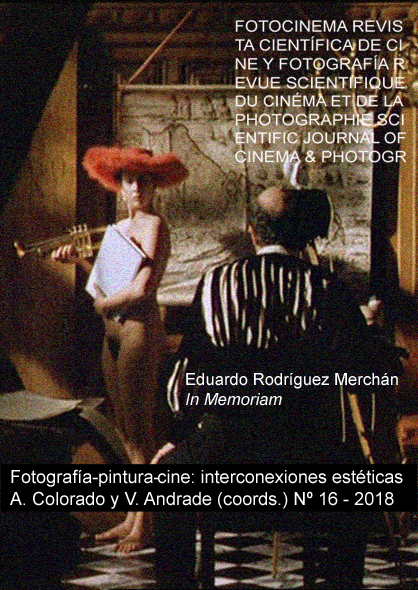Les Mystères du château du dé, revealed by Man Ray. The cinema painted, photographed, thought
DOI:
https://doi.org/10.24310/Fotocinema.2018.v0i16.4086Keywords:
Man Ray, Dada, Cinema, Photography, Painting, Avant-gardeAbstract
Les Mystères du château du dé was the last of the films directed by Man Ray as a personal request (from the marquess of Noailles), under guidelines and was subsequently shown to the public. Far beyond documenting the fun of the aristocracy in a luxury avant-garde environment, it is the expression of an elaborated purpose of aesthetic thought. It is a process of exaltation of the union of the arts projected on the big screen, reaching the paroxysm in the generation of an independent universe from the one that is given, being neither an imitation nor a fragment taken from reality and dependent of it. Man Ray has created a place for utopia, and so doing he is closer to creators of alternative worlds, and also he culminates the regeneration project that was Dada's main aim.
Downloads
Metrics
Publication Facts
Reviewer profiles N/A
Author statements
Indexed in
-
—
- Academic society
- N/A
- Publisher
- Universidad de Málaga
References
AA.VV. (1977). Le Grand Jeu. Paris: Jean-Michel Place.
Abbot, E. A. (2004). Planilandia. Una novela de muchas dimensiones. Palma de Mallorca: José J. de Olañeta
Apollinaire, G. (1998). Obra poética. Tomo I. Barcelona: 29.
Baldwin, N. (1990). Man Ray. Une vie d’artiste. Paris: Plon.
Benaïm, L. (2003). Marie Laure de Noailles. La vicomtesse du bizarre. Paris: Grasset & Fasquelle.
Bouhours, J.-M. (1981). Les Mystères du château du dé. La légende du château du dé. En AA.VV. Man Ray, photographe (pp. 82-123). Paris: Centre Pompidou/Philippe Sers.
Bouhours, J.-M. & De Haas, P. (1997). Man Ray, directeur du mauvais movies. Paris: Centre national d´art et de culture Georges Pompidou.
Briolle, C., Fuzibet, A. & Monnier, G. (1999). Mallet-Stevens. La villa Noailles. Paris: Parenthèses.
Carrouges, M. (1976). Les machines célibataires. Paris: Chène.
Cocteau, J. & Man Ray (1988). Barbette. Berlin: s. p.
Gamboni, D. (2002). Potential Images. Ambiguity and Indeterminacy in Modern Art. London: Reaktion Books.
Jarry, A. (1995). Gestes et opinions du Docteur Faustroll, pataphysicien. Paris: Gallimard. NRF.
L’Isle-Adam, V. (1993). L’Ève future. Paris : Gallimard.
Lux, J. A. (2002). "Estética de la ingeniería". En Maldonado, T. (comp.), Técnica y cultura. El debate alemán entre Bismarck y Weimar (pp. 83-99). Buenos Aires: Infinito.
Mallarmé, S. (1991). Antología. Madrid: Visor.
Mallet-Stevens, R. (1996). Le décor au Cinéma. Paris: Séguier.
Man Ray (1998). Autoportrait. Arles: Actes Sud.
Mumford, L. (1969). El mito de la máquina. Buenos Aires: Emecé.
Naumann, F. M. (2003). Conversion to Modernism. The Early Work of Man Ray. New Jersey: Rutgers University Press and Montclair Art Museum.
Puyol Loscertales, A. (2015). El periodo formativo de Man Ray. Historia cultural, técnica e ideología. Bases para su concepto estético y cinematográfico. Zaragoza: (en proceso de publicación).
Puyol Loscertales, A. (2017). "Le Retour à la raison, paradigma de film Dadá. Una presentación de la estética conceptual de Man Ray". Latente. Revista de Historia y Estética del Audiovisual, 27-44. Santa Cruz de Tenerife: Servicio de Publicaciones de la Universidad de La Laguna. https://riull.ull.es/xmlui/handle/915/2167/browse?value=Puyol+Loscertales%2C+Ana&type=author
Radrizzani, R. (1975). Roussel explorateur de nouveaux mondes. En VV.AA., Junggesellenmaschinen. Les machines célibataires. Civitanova Marche: Alfieri, edizioni d’arte, Industrie Grafiche Editoriali S.p.A, Venezia et Harald Szeeman.
Roussel, R. (2001). Locus Solus. Paris: Gallimard.
Sade, D.A.F. de (1995). Las 120 jornadas de Sodoma. Barcelona: Tusquets.
Shattuck, R. (1991). La época de los banquetes. Orígenes de la vanguardia en Francia: de 1885 a la Primera Guerra Mundial. Madrid: Visor.
Téllez, J. L. (1985-1986). La persistencia de la memoria. (Tres Films de Man Ray). En Sánchez Biosca, V., Company, J. M. & Pérez Perucha, J. (coords.), Contracampo. Revista de cine, nº 40-41, año II (pp. 97-101). Valencia: Contracampo & Instituto de Cine y Radio-Televisión.
Vaillant, O. (1995). Rationalisme et onirisme: les architectes et le cinéma. En Toulet, E. (dir.), Le cinéma au rendez-vous des arts. Paris: Bibliothèque Nationale de France.
Downloads
Published
How to Cite
Issue
Section
License
All contents published in Fotocinema Revista científica de cine y fotografía are protected under the Creative Commons Attribution-NonCommercial-ShareAlike 4.0 International (CC BY-NC-SA 4.0) license. All about this license is available in the following link: <http://creativecommons.org/licenses/by-nc-sa/4.0>
Users can copy, use, redistribute, share and exhibit publicly as long as:
- The original source and authorship of the material are cited (Journal, Publisher and URL of the work).
- It is not used for comercial purposes.
- The existence of the license and its especifications are mentioned.
There are two sets of authors’ rights: moral and property rights. Moral rights are perpetual prerogatives, unrenounceable, not-transferable, unalienable, imprescriptible and inembargable. According to authors’ rights legislation, Fotocinema. Revista científica de cine y fotografía recognizes and respects authors moral rights, as well as the ownership of property rights, which will be transferred to University of Malaga in open access. The property rights are referred to the benefits that are gained by the use or the dissemination of works. Fotocinema. Revista científica de cine y fotografía is published in an open access form and it is exclusively licenced by any means for doing or authorising distribution, dissemination, reproduction, , adaptation, translation or arrangement of works.
Authors are responsable for obtaining the necessary permission to use copyrighted images.














13.png)



